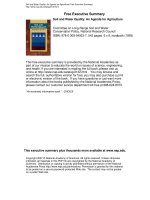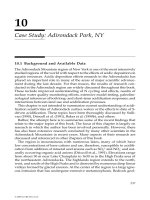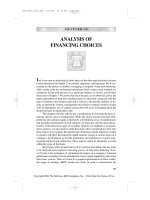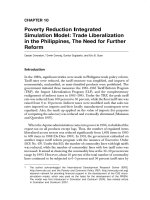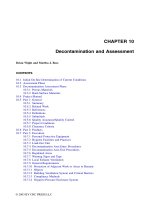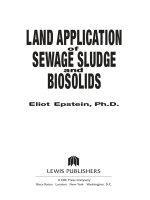Phytoremediation of Contaminated Soil and Water - Chapter 10 pot
Bạn đang xem bản rút gọn của tài liệu. Xem và tải ngay bản đầy đủ của tài liệu tại đây (431.16 KB, 12 trang )
10
The Role of Root Exudates
in Nickel
Hyperaccumulation and
Tolerance in Accumulator
and Nonaccumulator
Species of Thlaspi
David E. Salt, N. Kato, U. Krämer, R. D. Smith,
and I. Raskin
CONTENTS
Introduction
Experimental Approach
Recent Experimental Results
Implications of Recent Research Findings
Future Directions
Acknowledgments
References
INTRODUCTION
The association of plant species with soils rich in various heavy metals has long
been recognized (Antonovics, 1971). Examples of such distinct communities include
serpentine (i.e., growing on Mg-, Ni-, Cr-, and Co-rich soils), seleniferous (i.e.,
growing on Se-rich soils), uraniferous (i.e., growing on U-rich soils), calamine (i.e.,
growing on Zn- and Cd-rich soils), and Cr/Co floras. Metal hyperaccumulator plant
species are associated with these specialized metal floras, and they can concentrate
metals in their above-ground tissues to levels far exceeding the concentration of
metals present in the soil or in the nonaccumulating species growing nearby (Baker
and Brooks, 1989). Because of their enhanced ability to accumulate metals, a recent
U.S. Department of Energy (DOE) report concluded that “the genetic traits present
in hyperaccumulator plants offer potential for the development of practical phytore-
Copyright © 2000 by Taylor & Francis
mediation processes” (DOE/EM-0224, 1994). The genus Thlaspi (Brassicaceae)
contains several species which can hyperaccumulate Ni. T. goesingense Hálácsy
found growing on Ni-rich serpentinitic soils in Redschlag, Austria, can contain Ni
at concentrations up to 15,000 μg g
-1
in its shoot dry biomass (Reeves and Brooks,
1983). While the ecological role of metal hyperaccumulation is still unclear, recent
evidence suggests that it may protect plants against herbivory and attack by fungal
and bacterial pathogens (Boyd and Martens, 1994; Boyd et al., 1994; Pollard and
Baker, 1997).
It has been shown for a number of metal-hyperaccumulating species that shoot
metal concentrations reach very high levels after short-, medium-, or long-term
exposure to various, even low concentrations of metals in soil or hydroponic culture
(Homer et al., 1991; Lloyd-Thomas, 1995; Krämer et al., 1996, 1997). One possible
explanation for this enhanced Ni accumulation is that hyperaccumulator species may
release root exudates containing Ni-chelators with the potential to enhance Ni uptake,
translocation, and resistance. Among the compounds that have been proposed to
participate in Ni chelation in hyperaccumulators are citrate (Lee et al., 1978) and
free histidine (Krämer et al., 1996).
By comparing the composition of Ni-binding compounds in root exudates from
T. goesingense and the nonaccumulator species T. arvense, we have started to define
the role of root exudates in Ni hyperaccumulation and tolerance in the Thlaspi genus.
EXPERIMENTAL APPROACH
Seeds of T. arvense L. were obtained from the Crucifer Genetics Cooperative (Uni-
versity of Wisconsin, Madison). Seeds of T. goesingense Hálácsy were collected
from plants growing on a Ni-rich serpentinitic soil in Redschlag, Austria.
If not stated otherwise, seeds were germinated on filter paper moistened with
2.8 mmol L
-1
Ca(NO
3
)
2
for 1 week. Subsequently, 30 seedlings were transferred into
12 liter of hydroponic solution. Seedlings were initially supported by moist vermic-
ulite, and later by cotton wool. Solutions were continuously aerated and exchanged
in intervals of 7 to 18 days, according to plant size. Since growth rates of T.
goesingense were substantially lower than those of T. arvense, experiments were
performed using plants with equivalent numbers of leaves. The composition of all
hydroponic solutions was as follows: 0.28 mmol L
-1
Ca
2+
, 0.6 mmol L
-1
K
+
, 0.2
mmolL
-1
Mg
2+
, 0.1 mmol L
-1
NH
4
+
, 1.16 mmolL
-1
NO
3
-
, 0.1 mmol L
-1
H
2
PO
4
-
, 0.2
mmol L
-1
SO
4
2-
, 4.75 μmol L
-1
ferric tartrate, 0.03 μmol L
-1
Cu
2+
, 0.08 μmol L
-1
Zn
2+
, 0.5 μmol L
-1
Mn
2+
, 4.6 μmol L
-1
H
3
BO
3
and 0.01 μmol L
-1
MoO
3
(pH between
5.5 and 5.8). Plants were cultivated in the growth chamber with 10-h light periods.
Light was provided by fluorescent and incandescent lamps. All plants were main-
tained at day/night temperatures of 22°C and a constant humidity of 50%.
In these experiments, plant roots were grown axenically. Seeds were surface
sterilized by rinsing in 75% ethanol for 5 min, followed by incubation in 2.6% (w/v)
sodium hypochlorite containing 0.01% (v/v) Triton X-100 as a surfactant for 15
min. After 4 washes in sterile deionized water, seeds were transferred onto agar
plates containing 1 mmol L
-1
Ca(NO
3
)
2
, 2 mmol L
-1
KH
2
PO
4
, 4 mmol L
-1
KNO
3
,
0.3 mmol L
-1
MgSO
4
, 0.18 mmol L
-1
FeCl
3
, 42.26 μmol L
-1
H
3
BO
3
, 0.312 μmol L
-1
Copyright © 2000 by Taylor & Francis
CuSO
4
, 9.10 μmol L
-1
MnCl
2
, 0.106 μmol L
-1
MoO
3
, 0.765 μmol L
-1
ZnSO
4
, 3%
(w/v) sucrose, and 1.2% (w/v) agarose (pH 6.0 to 6.5) and germinated in the dark
for 1 week. The etiolated seedlings were transferred individually into small glass
vials containing 10 ml of sterile hydroponic solution. Soft styrofoam stoppers used
to cap the vials were incised radially to provide support for the hypocotyls. Solutions
were exchanged weekly and the vials were gently agitated on a rotary shaker (Lab-
line Instruments, Inc., Melrose Park, IL) at 60 rpm to provide aeration and mixing.
After various treatments outlined below, the hydroponic culture solution was col-
lected and treated as dilute root exudate.
Four-week-old T. goesingense and two-week-old T. arvense of uniform sizes
(three replicate plants for each time point), grown axenically as described above,
were exposed to 10 μm Ni(NO
3
)
2
in hydroponic culture solution. At 24-h intervals
over a 7 day period, one set of plants was harvested. Roots were dried at 80°C and
weighed. Hydroponic culture solution was aseptically transferred into centrifuge
tubes, reduced in volume in a rotary evaporator, and analyzed for amino acids.
Concentrated sterile root exudates were mixed with NiCl
2
traced with
63
Ni (59
μCi μmol
-1
Ni) and applied to a silica thin layer chromatography (TLC) plate. The
plate was developed in a solvent system containing water, 2-methoxyethanol, 1-
butanol, acetone, and ammonium hydroxide (20%) (45:20:25:10:0.15 v/v), dried and
placed face down onto a phosphoimager screen to visualize the
63
Ni.
Four-week-old T. goesingense and two-week-old T. arvense of uniform sizes
(three replicate plants for each treatment), grown axenically as described above,
were exposed to 25 μm Ni(NO
3
)
2
, Co(NO
3
)
2
, Zn(NO
3
)
2
, or Cd(NO
3
)
2
added to the
hydroponic culture solution. After 48 h, hydroponic culture solution was exchanged,
and the plants were exposed to Ni, Co, Zn, or Cd for a further 48 h. Plants were
harvested, separated into shoots and roots, dried at 80°C, and weighed. The hydro-
ponic culture solution was aseptically transferred into centrifuge tubes, reduced in
volume in a rotary evaporator, and analyzed for amino acids or other unknown Ni-
chelating compounds using TLC.
Four-week-old T. goesingense and two-week-old T. arvense of uniform size,
grown axenically as described above, were aseptically transferred into glass vials,
containing 10 μmol L
-1
Ni(NO
3
)
2
, in 10 ml of hydroponic culture solution. Transfers
were made so that each vial contained either a pair of T. goesingense, a pair of T.
arvense, or both T. goesingense and T. arvense. Each treatment was replicated four
times. The hydroponic culture solution was changed daily, and plants were harvested
after 7 days. Plants were separated into shoots and roots, dried at 80°C, and weighed.
Dried plant material was wet ashed and analyzed for Ni by inductively coupled
plasma spectrometry (ICP; Fisons Accuris, Fisons Instruments, Inc., Beverly, MA).
Amino acids in sterile root exudates were analyzed after derivatization with o-
phthalaldehyde (OPA) by HPLC (Jones and Gilligan, 1983).
The compound preliminarily identified as citrate from the TLC Ni-binding assay
was collected from a preparative TLC plate, eluted from the silica with water, and
derivatized using N-methyl-N-trimethylsilyl-trifluoroacetimide (MSTFA) with 1%
trimethylchlorosilane (TMCS). The sample was dissolved in pyridine, MSTFA +
1% TMCS was added, and the reaction mixture was heated to 60°C in a sealed
reaction vial. After heating, the sample was dried under nitrogen, dissolved in
Copyright © 2000 by Taylor & Francis
pyridine, and injected into a Hewlett Packard gas chromatograph mass spectrometer
(5890 GC/5971A MS). Compounds were identified from their fragmentation pat-
terns.
Dried plant material was wet ashed using nitric acid and perchloric acid accord-
ing to standard methods (Jones and Case, 1990). The resulting solution was analyzed
for metal content by ICP. Certified National Institute of Standards and Technology
plant (peach leaf) standards were carried through the digestions and analyzed as part
of the QA/QC protocol. Reagent blanks and spikes were used where appropriate to
ensure accuracy and precision.
RECENT EXPERIMENTAL RESULTS
In the absence of Ni-chelating compounds,
63
Ni was found to remain localized at
the origin on the TLC plate (Figure 10.1, lane B). However, in the presence of the
Ni-chelates histidine and citrate,
63
Ni moved from the origin as discrete spots with
Rf values of 0.18 and 0.8, respectively (Figure 10.1, lanes A, C). By mixing various
unknown compounds with
63
Ni and applying the mixture to a TLC plate, it was
possible to determine if these unknown compounds were able to chelate Ni by their
ability to enhance the mobility of
63
Ni on the TLC plate. Using this assay it was
determined that sterile root exudate from the hyperaccumulator T. goesingense
contained no major Ni-chelating compounds (Figure 10.1, lanes D, E). In contrast,
root exudate from the nonhyperaccumulator T. arvense appeared to contain two
major compounds capable of chelating Ni (Figure 10.1, lane F). These two com-
FIGURE 10.1 Silica TLC plate containing Ni-binding compounds. All samples were spiked
with NiCl
2
containing
63
Ni (59 μCi μmol
-1
Ni), loaded at the origin, and the plate developed
in a solvent system containing water, 2-methoxyethanol, 1-butanol, acetone, and ammonium
hydroxide (20%; 45:20:25:10:0.15 v/v). The plate was air-dried and the
63
Ni imaged using a
phosphoimager. Lane (A) histidine (7 nmol); (B) water; (C) citrate (0.1 μmol); (D) Root
exudate from T. goesingense exposed to 25 µm Ni(NO
3
)
2
for 48 h; (E) Root exudate from T.
goesingense not exposed to Ni; (F) Root exudate from T. arvense exposed to 25 μm Ni(NO
3
)
2
for 48 h; (G) Root exudate from T. arvense not exposed to Ni.
Copyright © 2000 by Taylor & Francis
pounds had the same Rf values as histidine and citrate (Figure 10.1, lanes A, C) and
appeared to accumulate mainly in root exudates produced by T. arvense exposed to
Ni (Figure 10.1, lanes F, G). Further analysis, by GCMS, of the compound with a
similar Rf value to citrate confirmed the presence of citrate in this material.
Histidine exudation from roots of the hyperaccumulator T. goesingense was 3.7
± 0.6 nmol g
-1
root dry biomass over a 24-h period (Figure 10.2), and did not change
significantly after exposure to 10 μm Ni(NO
3
)
2
(Figure 10.2). In contrast, root
exudation of histidine in the nonhyperaccumulator T. arvense increased from 30.3
± 15.9 nmol g
-1
root dry biomass to a mean production of 127 ± 48 nmol His g
-1
root dry biomass after exposure to 10 μm Ni nitrate (Figure 10.2).
Root exudation of histidine, serine, glycine, and glutamine in T. goesingense
remained relatively constant after exposure to 25 μm Ni(NO
3
)
2
(Table 10.1, Figure
10.3A). However, exposure to 25 μm Co(NO
3
)
2
, Zn(NO
3
)
2
, or Cd(NO
3
)
2
suppressed
amino acid release (Table 10.1, Figure 10.3A). In contrast, roots of the nonhyper-
accumulator T. arvense responded to Ni exposure by specifically increasing exuda-
tion of histidine from 12 ± 5 to 286 ± 162 nmol g
-1
root dry biomass (Table 10.2,
Figure 10.3B). Smaller increases in histidine were also observed on exposure to Co,
Zn, and Cd (Table 10.2, Figure 10.3B). Glutamine concentration also increased in
root exudates of T. arvense exposed to Cd from 21 ± 1 to 193 ± 48 nmol g
-1
root
dry biomass (Table 10.2, Figure 10.3B).
Nickel concentrations in shoots of the nonhyperaccumulator T. arvense were 4.2
± 0.3 μmol g
-1
dry biomass and decreased slightly to 2.0 ± 0.35 μmol g
-1
dry biomass
after growth in the presence of the hyperaccumulator T. goesingense (Table 10.3).
Root Ni concentrations of 15 μmol g
-1
dry biomass were measured in T. arvense
FIGURE 10.2 Histidine production in root exudates of T. goesingense and T. arvense. Sterile
root exudates were collected over a 24-h period from plants exposed to 10 μm Ni(NO
3
)
2
in
hydroponic culture for 0 to 7 days. Root exudates were concentrated in a rotary evaporator
and analyzed for amino acids by HPLC after derivatization with o-phthaladehyde (OPA). Data
points represent mean values ±SD where n = 3.
Copyright © 2000 by Taylor & Francis
growing separately or together with T. goesingense (Table 10.3). Nickel concentra-
tions in shoots and roots of T. goesingense increased slightly after co-culture with
T. arvense and shoot Ni concentrations increased from 14 ± 2.7 μmol g
-1
dry biomass
to 18 ± 1.7 μmol g
-1
dry biomass, and root concentrations increased from 3.7 ± 1.3
μmol g
-1
dry biomass to 6.6 ± 1.4 μmol g
-1
dry biomass (Table 10.3).
IMPLICATIONS OF RECENT RESEARCH FINDINGS
We have shown previously that T. goesingense grown in hydroponic culture accu-
mulates high concentrations of Ni in shoots and also tolerates high Ni concentrations
in both shoots and the hydroponic culture solution (Krämer et al., 1997). However,
in the closely related species T. arvense, shoot Ni concentrations were found to be
low, and a significant reduction in shoot biomass was detected after Ni exposure
(Krämer et al., 1997). Intriguingly, the Ni content of roots displayed the opposite
trend, with root Ni concentrations being higher in T. arvense than in T. goesingense.
The existence of a more efficient root-to-shoot Ni translocation mechanism in T.
goesingense would be one possible explanation for the enhanced shoot Ni accumu-
lation observed in the hyperaccumulator species T. goesingense. However, it was
recently demonstrated that at nontoxic Ni concentrations both T. arvense and T.
goesingense translocate Ni to shoots at equivalent rates (Krämer et al., 1997).
The release of specific metal-chelating compounds into the rhizosphere by plant
roots is a well established phenomenon involved in the solubilization and uptake of
Fe (Ma and Nomoto, 1996) and possibly Zn (Cakmak et al., 1996a,b). Therefore,
it is appealing to suggest that similar Ni-specific chelators may be involved in the
Ni hyperaccumulation phenotype observed in T. goesingense. However, using a TLC-
based assay system, we were unable to identify any high-affinity Ni-chelating com-
pounds in the root exudate of the Ni hyperaccumulator T. goesingense (Figure 10.1).
In contrast, we observed that the Ni-chelators histidine and citrate accumulate in the
root exudate of the nonhyperaccumulator T. arvense during exposure to 25 μm Ni
for 48 h (Figure 10.1). Further analysis of root exudates from T. goesingense and
T. arvense confirmed that histidine levels in root exudates remain unchanged in the
TABLE 10.1
Amino Acids in Sterile Root Exudates of T.
goesingense Exposed to Various Metals
His Ser Gly Gln
Control 21 ± 7 156 ± 55 174 ± 42 20 ± 10
Ni 25 ± 6 185 ± 100 138 ± 68 12 ± 4
Co 24 ± 3 35 ± 4 31 ± 5 4 ± 1
Zn 12 ± 4 88 ± 73 94 ± 68 17 ± 22
Cd 8 ± 1 47 ± 17 42 ± 10 7 ± 2
Note:nmol g
-1
root dry biomass (SD; n = 3).
Copyright © 2000 by Taylor & Francis
hyperaccumulator T. goesingense and increase in the nonhyperaccumulator T.
arvense on exposure to Ni (Tables 10.1 and 10.2, Figures 10.2 and 10.3). Histidine
concentrations in root exudates of T. arvense after Ni exposure are also at least 10-
fold higher than in T. goesingense (Tables 10.1 and 10.2, Figure 10.2). These data
suggest that histidine, exuded by roots, does not play a significant role in the
enhanced foliar Ni accumulation observed in the Ni hyperaccumulator T. goesin-
gense. It is possible that Ni-chelating compounds exuded by roots, but not detected
using the TLC Ni-binding assay described here, are involved in Ni hyperaccumula-
FIGURE 10.3 Changes in the amino acid profile of root exudates of T. goesingense (A) and
T. arvense (B) after exposure to Ni, Co, Zn, and Cd. Sterile root exudates were collected over
a 48-h period from plants exposed to either 25 μm Ni(NO
3
)
2
, Co(NO
3
)
2
, Zn(NO
3
)
2
, or
Cd(NO
3
)
2
. Root exudates were concentrated in a rotary evaporator and analyzed for amino
acids by HPLC after derivatization with o-phthaladehyde (OPA). Data is presented as a ratio
of the amino acid exudation in the presence of metal, divided by production in the absence
of metal. The dashed line represents an amino acid accumulation ratio of 1 signifying that
amino acid production remained constant. Data used in these calculations are presented in
Tables 10.1 and 10.2.
Copyright © 2000 by Taylor & Francis
tion. However, experiments in which T. goesingense was co-cultured with T. arvense
(Table 10.3) suggest that if these compounds exist they cannot be utilized by closely
related nonhyperaccumulator species to enhance Ni uptake.
Even though root-exudate histidine does not appear to be involved in Ni hyper-
accumulation in T. goesingense, the question remains as to its function in the non-
hyperaccumulator T. arvense. Release of Al chelators, including citric and malic
acids, into the rhizosphere reduces the chemical activity of the toxic Al
3+
ion in
solution and is known to be involved in Al resistance in certain Al-tolerant plant
cultivars (Kochian, 1995). This raises the intriguing possibility that the specific
release of histidine by T. arvense roots may be part of a Ni detoxification strategy.
Histidine forms stable complexes with Ni
2+
(Sundberg and Martin, 1974) and may
be expected to chelate Ni in the rhizosphere, reducing the solution activity of the
Ni
2+
ion and thereby lowering its toxicity. The release of citrate by T. arvense into
TABLE 10.2
Amino Acids in Sterile Root Exudates of T. arvense
Exposed to Various Metals
His Ser Gly Gln
Control 12 ± 5 133 ± 52 89 ± 28 21 ± 1
Ni 286 ± 162 157 129 34
Co 50 ± 23 201 ± 108 164 ± 82 44 ± 15
Zn 89 ± 123 184 ± 33 154 ± 14 76 ± 24
Cd 47 ± 3 183 ± 61 144 ± 47 193 ± 48
Note: nmol g
-1
root dry biomass (SD; n = 3).
TABLE 10.3
Nickel Accumulation During Hydroponic Co-
Culture of Thlaspi Species
Species Shoots Roots
Thlaspi goesingense
a
GG 14.0 ± 2.0 3.7 ± 0.9
GA 18.0 ± 1.5 6.6 ± 1.2
T. arvense
a
AA 4.2 ± 0.3 14.6 ± 1.1
AG 2.0 ± 0.3 14.9 ± 0.7
Note: μmol Ni g
-1
dry biomass (SD; n = 4).
a
Plants cultured as follows: GG, T. goesingense; GA, T. goesin-
gense and T. arvense; AA, T. arvense; AG, T. arvense and T.
goesingense.
Copyright © 2000 by Taylor & Francis
the rhizosphere would also be expected to lower Ni toxicity by chelation of Ni
2+
(Dawson et. al., 1986). It is therefore possible that the enhanced release of both
histidine and citrate by T. arvense roots may be a plausible strategy to reduce Ni
uptake and toxicity (Cumming and Taylor, 1990). However, it is clear that this
mechanism is rapidly overwhelmed at elevated Ni concentrations in the Ni nontol-
erant T. arvense used in this study (Krämer et al., 1997). It is interesting to speculate
that the enhancement of this type of mechanism may be involved in the adaptation
of certain Ni-tolerant plant ecotypes to growth on Ni-enriched soils (Cox and Hutch-
inson, 1979).
Therefore, release of histidine and citrate into the rhizosphere does not appear
to play an important role in Ni hyperaccumulation in T. goesingense. However, root
exudation of the Ni chelators histidine and citrate may play a role in the reduction
of Ni uptake and toxicity in nonhyperaccumulator plants such as T. arvense.
FUTURE DIRECTIONS
Recent data from our laboratory suggest that Ni tolerance is sufficient to explain the
Ni hyperaccumulation phenotype observed in hydroponically cultured T. goesin-
gense when compared with the Ni-sensitive nonaccumulator T. arvense (Krämer et
al., 1997). The fact that protoplasts isolated from T. goesingense were more Ni-
tolerant than those isolated from T. arvense suggests the existence of a cellular
mechanism of Ni tolerance in the leaves of the hyperaccumulator. Our future research
efforts therefore will be to address the biochemical and molecular basis of Ni
detoxification in T. goesingense.
By isolating protoplasts and intact vacuoles from leaves of T. goesingense, and
using
63
Ni as a sensitive tracer for Ni, we are working toward gaining a better
understanding of the distribution of Ni in the leaves of the hyperaccumulator. Our
preliminary data suggest that cellular Ni is localized within the vacuole of the
hyperaccumulator, as has been found for Cd (Volgeli-Lange and Wagner, 1990) and
Zn (Brune et al., 1994). If this is confirmed, we will proceed to investigate the
mechanism(s) of Ni transport across the tonoplast using the techniques applied to
investigating the tonoplast transport of Cd (Salt and Wagner, 1993; Salt and Rauser,
1995).
In support of these localization studies, we have also been using x-ray spectros-
copy as a noninvasive tool to establish the speciation of Ni within the Ni hyperac-
cumulator and nonaccumulator plants. Our data suggest that the majority of cellular
Ni in T. goesingense is associated with organic acids. As the major pool of organic
acids within plant cells is known to be vacuolar, this observation supports the
vacuolar localization for Ni in the hyperaccumulator. However, in the Ni non-tolerant
nonaccumulator T. arvense, up to 45% of the foliar Ni appears to be associated with
histidine-like ligands (containing N and O-Ni coordination sites). This represents a
sevenfold higher concentration of Ni in this form than in the hyperaccumulator,
suggesting that in the Ni nontolerant plants, Ni accumulates within the cytoplasm,
where it is coordinated by mixed N-O ligands within proteins and possibly nucleic
acids. It is this uncontrolled binding of Ni within the cytoplasm of the cells that
Copyright © 2000 by Taylor & Francis
leads to the toxic symptoms observed in these Ni nontolerant nonaccumulator plants
after Ni treatment.
Recently, free histidine has been proposed to play a key role in Ni hyperaccu-
mulation in several species of Alyssum (Krämer et al., 1996). Exposure of these
plants to Ni caused a pronounced increase in the xylem sap concentration of free
histidine, and the concentration of histidine was directly correlated with the Ni
concentration in the sap. Because of these interesting findings, we have also been
investigating the possible involvement of histidine in Ni hyperaccumulation in T.
goesingense. Our preliminary observations have revealed that there are no significant
increases in free histidine concentrations in either xylem sap or bulk extracts of
shoot or root tissue of T. goesingense after Ni exposure. However, in order to
investigate the possible involvement of free histidine in Ni hyperaccumulation in
more detail at the tissue and cellular level, we have cloned, by functional comple-
mentation in E. coli mutants, three key genes involved in the biosynthesis of histidine:
ATP phosphoribosyl transferase (ATP PRT), imidazoleglycerol phosphate dehy-
dratase (IGPD), and histidinol dehydrogenase (HD). We are now studying the reg-
ulation of these enzymes by Ni and the regulation of gene expression during Ni
exposure.
By investigating the basic physiology, biochemistry, and molecular biology of
Ni hyperaccumulation in T. goesingense we hope to be able to define, at the genetic
level, the key processes that determine the Ni hyperaccumulation phenotype. This
knowledge will then be used to create plants more ideally suited to the phytoreme-
diation of metal-contaminated soils and waters.
ACKNOWLEDGMENTS
This research was supported by the U.S. Department of Energy Grant No. DE-FG07-
96ER20251 to D.E.S, a NATO fellowship awarded to U.K. by the German Academic
Exchange Service (DAAD), and by Phytotech, Inc. to I.R. We would like to thank
Dr. David M. Ribnicky for his assistance in the derivatization and analysis of samples
by GCMS, and Dr. Angus Murphy for his help in the analysis of the GCMS mass
profiles. We would also like to thank Dr. Xianghe Yan for cloning of the histidine
biosynthetic genes, and Dr. Ingrid Pickering and Dr. Roger Prince for assistance
with the collection and analysis of the x-ray spectroscopy data at the Stanford
Synchrotron Radiation Laboratory, Stanford, CA.
REFERENCES
Antonovics, J., Bradshaw, A.D., and Turner, R.G. (1971) Heavy metal tolerance in plants.
Adv. Ecol. Res. 7: 1-85.
Baker, A.J.M. and Brooks, R.R. (1989) Terrestrial higher plants which hyperaccumulate
metallic elements — a review of their distribution, ecology and phytochemistry.
Biorecovery 1: 81-126.
Boyd, R.S. and Martens, S.N. (1994) Nickel hyperaccumulated by Thlaspi montanum var.
montanum is acutely toxic to an insect herbivore. Oikos 70: 21-25.
Copyright © 2000 by Taylor & Francis
Boyd, R.S., Shaw, J.J., and Martens, S.N. (1994) Nickel hyperaccumulation defends Strep-
tanthus polygaloides (Brassicaceae) against pathogens. Am. J. Bot. 81: 294-300.
Brune, A., Urbach, W., and Dietz, K J. (1994) Compartmentation and transport of zinc in
barley primary leaves as basic mechanisms involved in zinc tolerance. Plant Cell.
Environ. 17: 153-62
Cakmak, I., Sari, N., Marschner, H., Ekiz, H., Kalayci, M., Yilmaz, A., and Braun, H.J.
(1996a) Phytosiderophore release in bread and durum wheat genotypes differing in
zinc efficiency. Plant Soil 180: 183-189.
Cakmak, I., Ozturk, L., Karanlik, S., Marschner, H., and Ekiz, H. (1996b) Zinc-efficient wild
grasses enhance release of phytosiderophores under zinc deficiency. J. Plant Nutr.
19: 551-563.
Cox, R.M. and Hutchinson, T.C. (1979) Metal co-tolerance in the grass Deschampsia cae-
spitosa. Nature 279: 231-233.
Cumming, J.R. and Taylor, G.J. (1990) Mechanisms of metal tolerance in plants: physiological
adaptations for exclusion of metal ions from the cytoplasm. 329-359. In Stress
Responses in Plants: Adaptation and Acclimation Mechanisms. Alscher, R.G. and
Cumming, J.R. (Eds.). Wiley-Liss.
Dawson, R.M.C., Elliott, D.C., Elliott, W.H., and Jones, K.M., Eds. (1986) Data for Bio-
chemical Research, 3rd ed., Clarendon Press, Oxford, U.K.
DOE/EM-0224, (1994) Summary Report of a Workshop on Phytoremediation Research
Needs, July 24-26, Santa Rosa, CA.
Homer, F.A., Morrison, R.S., Brooks, R.R., Clemens, J., and Reeves, R.D. (1991) Comparative
studies of nickel, cobalt and copper uptake by some nickel hyperaccumulators of the
genus Alyssum. Plant Soil 138: 195-205.
Jones, J.B., Jr. and Case, V.V. (1990) Soil Testing and Plant Analysis, 3rd ed.; Westerman,
R.L. (Ed.); SSSA Book Series, No. 3. Soil Science Society of America, Madison, WI.
Jones, B.N. and Gilligan, J.P. (1983) o-Phthalaldehyde precolumn derivatization and reversed-
phase high-performance liquid chromatography of polypeptide hydrolysates and
physiological fluids. J. Chromatogr. 266: 471-482.
Kochian, L.V. (1995) Cellular mechanisms of aluminum toxicity and resistance in plants.
Ann. Rev. Plant Physiol. Plant Mol. Biol. 46: 237-260.
Krämer, U., Cotter-Howells, J.D., Charnock, J.M., Baker, A.J.M., and Smith, J.A.C. (1996)
Free histidine as a metal chelator in plants that accumulate nickel. Nature 379: 635-
638.
Krämer, U., Smith, R.D., Wenzel, W.W., Raskin, I., and Salt, D.E. (1997) The role of metal
transport and tolerance in nickel hyperaccumulation by Thlaspi goesingense Hálácsy.
Plant Physiol. 115: 1641-1650.
Lee, J., Reeves, R.D., Brooks, R.R., and Jaffré, T. (1978) The relation between nickel and
citric acid in some nickel-accumulating plants. Phytochemistry 17: 1033-1035.
Lloyd-Thomas, D.H. (1995) Heavy metal hyperaccumulation by Thlaspi caerulescens J. &
C. Presl. Ph.D. thesis. University of Sheffield, Sheffield, U.K.
Ma, J.F. and Nomoto, K. (1996) Effective regulation of iron acquisition in graminaceous
plants — the role of mugineic acids as phytosiderophores. Physiol. Plant 97: 609-617.
Pollard, A.J. and Baker, A.J.M. (1997) Deterrence of herbivory by zinc hyperaccumulation
in Thlaspi caerulescens (Brassicaceae). New Phytol. 135, 655-658.
Reeves, R.D. and Brooks, R.R. (1983) European species of Thlaspi L. (Cruciferae) as indi-
cators of nickel and zinc. J. Geochem. Explor. 18: 275-283.
Salt, D.E. and Rauser, W.E. (1995) MgATP-dependent transport of phytochelatins across the
tonoplast of oat roots. Plant Physiol. 107: 1293-301.
Copyright © 2000 by Taylor & Francis
Salt, D.E. and Wagner, G.J. (1993) Cadmium transport across tonoplast of vesicles from oat
roots. Evidence for a Cd
+2
/H
+
antiport activity. J. Biol. Chem. 268: 12297-302.
Sundberg, R.J. and Martin, R.B. (1974) Interactions of histidine and other imidazole deriva-
tives with transition metal ions in chemical and biological systems. Chem. Rev. 74:
471-517.
Vogeli-Lange, R. and Wagner, G.J. (1990) Subcellular localization of cadmium-binding pep-
tides in tobacco leaves. Implications of a transport function for cadmium-binding
peptides. Plant Physiol. 92: 1086-93.
Copyright © 2000 by Taylor & Francis
